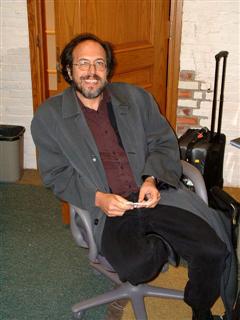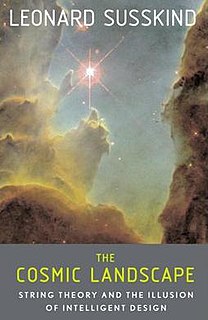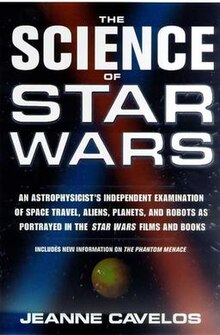
The multiverse is a hypothetical group of multiple universes including the universe in which we live. Together, these universes comprise everything that exists: the entirety of space, time, matter, energy, and the physical laws and constants that describe them. The different universes within the multiverse are called "parallel universes", "other universes", or "alternate universes".

Physics is the natural science that studies matter and its motion and behavior through space and time and that studies the related entities of energy and force. Physics is one of the most fundamental scientific disciplines, and its main goal is to understand how the universe behaves.
The following outline is provided as an overview of and topical guide to physics:
The technology in Star Trek has borrowed freely from the scientific world to provide storylines. Episodes are replete with references to tachyon beams, baryon sweeps, quantum fluctuations and event horizons. Many of the technologies created for the Star Trek universe were done so out of simple financial necessity—the transporter was created because the limited budget of the original series in the 1960s did not allow expensive shots of spaceships landing on planets.

Sir Roger Penrose is an English mathematical physicist, mathematician and philosopher of science. He is Emeritus Rouse Ball Professor of Mathematics in the University of Oxford and Emeritus Fellow of Wadham College, Oxford.

The following outline is provided as an overview of and topical guide to space science:

A Brief History of Time: From the Big Bang to Black Holes is a popular-science book on cosmology by British physicist Stephen Hawking. It was first published in 1988. Hawking wrote the book for nonspecialist readers with no prior knowledge of scientific theories.
Eternalism is a philosophical approach to the ontological nature of time, which takes the view that all existence in time is equally real, as opposed to presentism or the growing block universe theory of time, in which at least the future is not the same as any other time. Some forms of eternalism give time a similar ontology to that of space, as a dimension, with different times being as real as different places, and future events are "already there" in the same sense other places are already there, and that there is no objective flow of time. It is sometimes referred to as the "block time" or "block universe" theory due to its description of space-time as an unchanging four-dimensional "block", as opposed to the view of the world as a three-dimensional space modulated by the passage of time.

Lee Smolin is an American theoretical physicist, a faculty member at the Perimeter Institute for Theoretical Physics, an adjunct professor of physics at the University of Waterloo and a member of the graduate faculty of the philosophy department at the University of Toronto. Smolin's 2006 book The Trouble with Physics criticized string theory as a viable scientific theory. He has made contributions to quantum gravity theory, in particular the approach known as loop quantum gravity. He advocates that the two primary approaches to quantum gravity, loop quantum gravity and string theory, can be reconciled as different aspects of the same underlying theory. His research interests also include cosmology, elementary particle theory, the foundations of quantum mechanics, and theoretical biology.
The space opera interstellar epic Star Wars uses science and technology in its settings and storylines. The series has showcased many technological concepts, both in the movies and in the expanded universe of novels, comics and other forms of media. The Star Wars movies' primary objective is to build upon drama, philosophy, political science and less on scientific knowledge. Many of the on-screen technologies created or borrowed for the Star Wars universe were used mainly as plot devices.

Michio Kaku is an American theoretical physicist, futurist, and popularizer of science. He is a professor of theoretical physics in the City College of New York and CUNY Graduate Center. Kaku has written several books about physics and related topics, has made frequent appearances on radio, television, and film, and writes online blogs and articles. He has written four New York Times best sellers: Physics of the Impossible (2008), Physics of the Future (2011), The Future of the Mind (2014). Kaku has hosted several TV specials for the BBC, the Discovery Channel, the History Channel, and the Science Channel.

The Fabric of the Cosmos: Space, Time, and the Texture of Reality (2004) is the second book on theoretical physics, cosmology, and string theory written by Brian Greene, professor and co-director of Columbia's Institute for Strings, Cosmology, and Astroparticle Physics (ISCAP).

Michael S. Turner is a theoretical cosmologist, who coined the term dark energy in 1998. He is the Bruce V. & Diana M. Rauner Distinguished Service Professor at the University of Chicago, and was formerly the Assistant Director for Mathematical and Physical Sciences for the US National Science Foundation from 2003–2006. His book The Early Universe, co-written with fellow Chicago cosmologist Rocky Kolb and published in 1990, is a standard text on the subject.

Sean Michael Carroll is a theoretical physicist specializing in quantum mechanics, gravity, and cosmology. He is a research professor in the Department of Physics at the California Institute of Technology. He has been a contributor to the physics blog Cosmic Variance, and has published in scientific journals such as Nature as well as other publications, including The New York Times, Sky & Telescope, and New Scientist.

Physics of the Impossible: A Scientific Exploration Into the World of Phasers, Force Fields, Teleportation, and Time Travel is a book by theoretical physicist Michio Kaku. Kaku uses discussion of speculative technologies to introduce topics of fundamental physics to the reader. The topic of invisibility becomes a discussion on why the speed of light is slower in water than in vacuum, that electromagnetism is similar to ripples in a pond, and Kaku discusses newly developed composite materials. The topic of Star Trek "phasers" becomes a lesson on how lasers work and how laser-based research is conducted. The cover of his book depicts a TARDIS, a device used in the British science fiction television show Doctor Who to travel in space and time, in its disguise as a police box, continuously passing through a time loop. With each discussion of science fiction technology topics he also "explains the hurdles to realizing these science fiction concepts as reality".

The Cosmic Landscape is a non-fiction popular science book on the anthropic principle and string theory landscape. It is written by theoretical physicist Leonard Susskind. The book was initially published by Little, Brown and Company on December 12, 2005.
Quantum fiction is a literary genre that reflects modern experience of the material world and reality as influenced by quantum theory and new principles in quantum physics. The genre is not necessarily science-themed and blurs the line separating science fiction and fantasy into a broad scope of mainstream literature that transcends the mechanical model of science and involves the fantasy of human perception or imagination as realistic components affecting the every day physical world. Quantum fiction is characterized by the use of an element in quantum mechanics as a storytelling device. In quantum fiction, everyday life hinges on some aspect of the quantum nature of reality.
The space opera blockbuster Star Wars has borrowed many real-life scientific and technological concepts in its settings. In return, Star Wars has depicted, inspired, and influenced several futuristic technologies, both in existence and under development. In the introduction of his Return of the Jedi novelization, author James Kahn wrote: "Star Wars is also very much concerned with the tension between humanity and technology, an issue which, for me, dates back even to my first films. In Jedi, the theme remained the same, as the simplest of natural forces brought down the seemingly invincible weapons of the evil Empire".

Beyond Star Trek: Physics from Alien Invasions to the End of Time is the fourth non-fiction book by the American theoretical physicist Lawrence M. Krauss. The book was initially published on November 7, 1997 by Basic Books and since then has appeared in five foreign editions.In his previous work, The Physics of Star Trek, Lawrence Krauss explained a number of ideas and concepts featured in the series; they may or may not exist in our universe. In this book, Krauss goes farther to discuss the realities of physics when it is applied to components from other sci-fi story lines.























